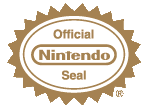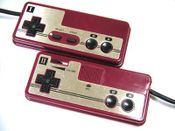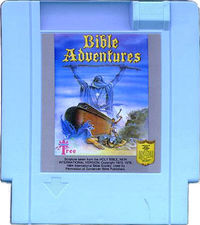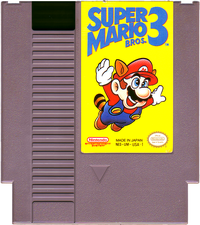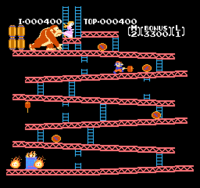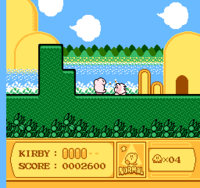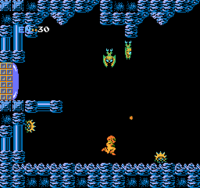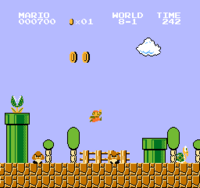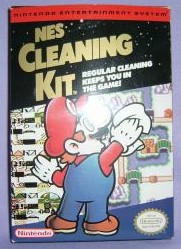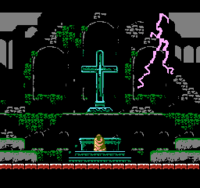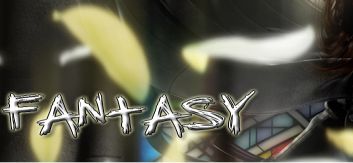Nintendo Entertainment System
Da Wikipedia, l'enciclopedia libera.
Il Nintendo Entertainment System (NES), meglio noto in Italia con il solo appelativo di Nintendo, è una console ad 8-bit distribuita dall'omonima casa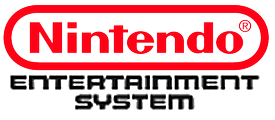 videoludica giapponese. In Giappone questa console è conosciuta con il nome Famicom, abbreviazione di Family Computer.
videoludica giapponese. In Giappone questa console è conosciuta con il nome Famicom, abbreviazione di Family Computer.
I giochi che fecero la fortuna di questo sistema di videogioco casalingo furono in particolare Super Mario Bros. 1, 2, 3 (Super Mario Bros. 3 è tuttora il gioco più venduto di tutti i tempi), Zelda 1 e 2, Metroid, Excitebike.
|
La Nintendo cessa la produzione di questa console nel 1994, lasciando spazio alla sorella maggiore a 16-bit: il Super Nintendo (Super NES in U.S.A. , Super Famicom in Giappone). L'ultimo gioco uscito per NES fu Wario's woods.
pezzi venduti 60 milioni
Ricavato da "http://it.wikipedia.org/wiki/Nintendo_Entert ainment_System"
The Nintendo Entertainment System, or NES, is an 8-bit video game console released by Nintendo in North America, Brazil, Europe, Asia, and Australia. Its Japanese equivalent is known as the Nintendo Family Computer, or Famicom. The most successful gaming console of its time in Asia and North America (Nintendo claims to have sold over 60 million NES units worldwide[4]), it helped revitalize the video game industry following the video game crash of 1983, and set the standard for subsequent consoles in everything from game design (the first modern platform game, Super Mario Bros., was the system’s first "killer game") to business practices. The NES was the first console for which the manufacturer openly courted third-party developers.History
Main article: History of the Nintendo Entertainment System
Success of titles like Donkey Kong at the video arcade encouraged Nintendo to enter the home console market.Following a series of arcade game successes in the early 1980s, Nintendo made plans to produce its own console hardware that had removable cartridges, a feature not included with the company’s earlier Color TV Games product. Designed by Masayuki Uemura and released in Japan on July 15, 1983, the Nintendo Family Computer (Famicom) was slow to gather momentum: during its first year, many criticized the system as unreliable, prone to programming errors and rampant freezing. Following a product recall and a reissue with a new motherboard, the Famicom’s popularity soared, becoming the best-selling game console in Japan by the end of 1984. Encouraged by their successes, Nintendo soon turned their attentions to the North American markets.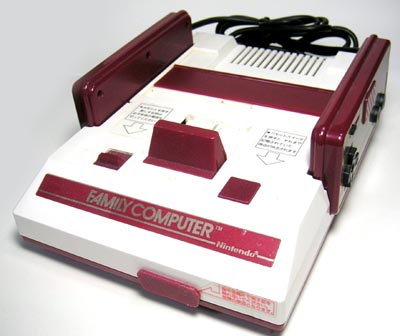
Super Mario Bros. was packaged alongside the NES deck for the North American launch of the console.Nintendo entered into negotiations with Atari to release the Famicom under Atari’s name as the name "Nintendo Enhanced Video System." This deal eventually fell through[5], and Atari decided to concentrate on its own next-generation 8-bit console, the Atari 7800.[6] Subsequent plans to market a Famicom console in North America featuring a keyboard, cassette data recorder, wireless joystick controller, and a special BASIC cartridge under the name "Nintendo Advanced Video System" likewise fell through. Finally, in June 1985 Nintendo unveiled its American version of the Famicom at the Consumer Electronics Show (CES). With a completely redesigned case and a new name, the Nintendo Entertainment System proved to be just as popular in America as the Famicom was in Japan, and played a major role in revitalizing interest in the video game industry. Originally Nintendo only released 50,000 units in New York City, and because of its great success it was released nationwide. Nintendo rolled out its first systems to limited American markets on October 18, 1985, following up with a nationwide release of the console in February of the following year.[7]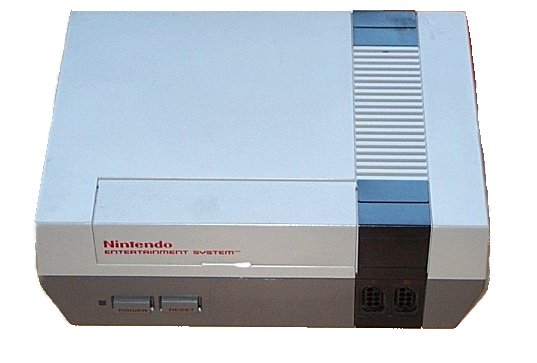
For the rest of the decade, Nintendo was the undisputed master of the American and Japanese gaming markets, and its game titles were breaking sales records. However, the console did not attain the same level of success in the rest of the western world. In Europe and Australia, the system was released to two separate marketing regions (A and B). Mattel handled distribution for region A, which consisted of the United Kingdom, Australia, and Italy. Distribution in region B, consisting of the rest of mainland Europe, was handled by a number of different companies, with Nintendo responsible for most cartridge releases. Not until 1990 did Nintendo's newly created European branch take over distribution throughout Europe.[8] This enabled competitor Sega to outperform the NES with its Sega Master System in many countries. Despite this, by 1990 the NES had become the best-selling console in video game history.[9]
Kirby’s Adventure, released in 1993, was one of the final licensed titles for the NES.As the 1990s dawned, however, renewed competition from technologically superior systems such as the 16-bit Sega Genesis (known as the Sega Mega Drive outside of North America) marked the end of the NES’s dominance. Eclipsed by Nintendo’s own Super Nintendo Entertainment System (SNES), the NES’s user base gradually waned. Nintendo continued to support the system in America through the first half of the decade, even releasing a new version of the console, the NES 2, to address many of the design flaws in the original NES hardware. By 1995, though, in the wake of ever decreasing sales and the lack of new software titles, Nintendo of America officially discontinued the NES. Despite this, Nintendo of Japan kept producing new Nintendo Famicoms for a niche market up until October 2003, when Nintendo of Japan officially discontinued the line.
In the years following the official "death" of the NES in the west, a collector’s market based around video rental shops, garage sales and flea markets led some gamers to rediscover the NES. Coupled with the growth of console emulation, the late 1990s saw something of a second golden age for the NES. The secondhand market began to dry up after 2000, and finding ROMs no longer represented the challenge it had in the past. Parallel to the rise of interest in emulation was the emergence of a dedicated NES hardware "modding" scene. Such hobbyists perform tasks such as moving the NES to a completely new case, or just dissecting it for parts or fun. The controllers are particular targets for modding, often being adapted to connect with personal computers by way of a parallel or USB port. Some NES modders have transformed the console into a portable system by adding AA batteries and an LED or LCD screen.
Regional differences
Although the Japanese Famicom and the international NES included essentially the same hardware, there were certain key differences between the two systems:
Different case design. The Famicom featured a top-loading cartridge slot, a 15-pin expansion port located on the unit’s front panel for accessories (as the controllers were hard-wired to the back of the console), and a red and white color scheme. The NES featured a front-loading cartridge slot (often jokingly compared to a toaster), and a more subdued gray, black and red color scheme. An expansion port was found on the bottom of the unit, and the cartridge connector pinout was changed.
In Japan, Metroid was released both in cartridge and diskette form for the Famicom Disk System.60-pin vs. 72-pin cartridges. The original Famicom and the re-released AV Family Computer both utilized a 60-pin cartridge design, which resulted in slightly smaller cartridges than the NES (and the NES 2), which utilized a 72-pin design. Four pins were used for the 10NES lockout chip.[10] Ten pins were added that connected a cartridge directly to the expansion port on the bottom of the unit. Finally, two pins that allowed cartridges to provide their own sound expansion chips were removed, a regrettable decision. Many early games (such as StackUp) released in North America were simply Famicom cartridges attached to an adapter (such as the T89 Cartridge Converter) to allow them to fit inside the NES hardware. Nintendo did this to reduce costs and inventory by using the same cartridge boards in America and Japan.
A number of peripheral devices and software packages were released in for the Famicom. Few of these devices were ever released outside of Japan.
Famicom Disk System (FDS). Although not included with the original system, a popular floppy disk drive peripheral was released for the Famicom in Japan only. Nintendo never released the Famicom Disk System outside of Japan, citing concerns about software bootlegging. Notable games released for the FDS include Doki Doki Panic, a special edition of Metroid, and the original Super Mario Bros. 2.[11]
Famicom BASIC was an implementation of BASIC for the Famicom. It allowed the user to program his or her own games. Many programmers got their first experience on programming for the console this way.
Famicom MODEM was a modem that allowed connection to a Nintendo server which provided content such as jokes, news (mainly about Nintendo), game tips, weather reports for Japan and allowed a small number of programs to be downloaded. 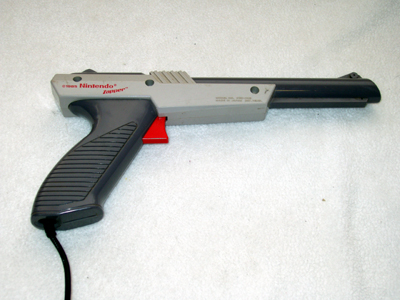
The NES version of Castlevania III suffered from inferior sound when compared to its Famicom counterpart.External sound chips. The Famicom had two cartridge pins that allowed cartridges to provide external sound enhancements. They were originally intended to facilitate the Famicom Disk System’s external sound chip. These pins were removed from the cartridge port of the NES, and relocated to the bottom expansion port. As a result, individual cartridges could not make use of this functionality, and many NES localizations suffered from inferior sound compared to their equivalent Famicom versions. Castlevania III: Dracula’s Curse is a notable example of this problem.
Hardwired controllers. The Famicom’s original design includes hardwired, non-removable controllers. In addition, the second controller featured an internal microphone for use with certain games. Both the controllers and the microphone were subsequently dropped from the redesigned AV Famicom in favor of the two seven-pin controller ports on the front panel used in the NES from its inception.
Lockout circuitry. The Famicom contained no lockout hardware, and, as a result, unlicensed cartridges (both legitimate and bootleg) were extremely common throughout Japan and the Far East. The original NES (but not the top-loading NES 2) contained the 10NES lockout chip, which significantly increased the challenges faced by unlicensed developers. Tinkerers at home in later years discovered that disassembling the NES and cutting the fourth pin of the lockout chip (a process now legal with the expiration of the NES patent) would cut power to the chip, removing all effects and greatly improving the console’s ability to play legal games, as well as bootlegs and converted imports.[12] The European release of the console used a regional lockout system that prevented cartridges released in region A from being played on region B consoles, and vice versa.[8]
Audio/video output. The original Famicom featured an RF modulator plug for audio/video output, while the original NES featured both an RF modulator and RCA composite output cables. The AV Famicom featured only RCA composite output, and the top-loading NES featured only RF modulator output.
Game controllers
The game controller used for the both the NES and Famicom featured a brick-like design with a simple four button layout: two round buttons labelled "B" and "A," a "Start" button, and a "Select" button. Additionally, they utilized the cross-shaped D-pad, designed by Nintendo employee Gunpei Yokoi for Nintendo Game & Watch systems, to replace the bulkier joysticks on earlier gaming consoles' controllers.
It is also possible that the Famicom/NES controllers may have been directly influenced by the controllers released with the Vectrex video game system in 1980. These controllers similarly featured a multidirectional, analog thumb pad/joystick on the left, and four horizontally arranged buttons.
Famicom controllers were simple in design, though they included a number of features, such as a microphone, missing from their NES counterparts.The original model Famicom featured two game controllers, both of which were hardwired to the back of the console. The second controller lacked the "Start" and "Select" buttons, but featured a small microphone. Relatively few games made use of this feature. The NES dropped the hardwired controllers, instead featuring two custom 7-pin ports on the front of the console. Also in contrast to the Famicom, the controllers included with the NES were identical to each other—the second controller lacked the microphone that was present on the Famicom model, and possessed the same "Start" and "Select" buttons as the primary controller.
Although it was arguably the most popular special controller released for the NES, even support for the Zapper was limited to a select few titles.A number of special controllers designed for use with specific games were released for the system, though very few such devices proved particularly popular. Such devices included, but were not limited to, the NES Zapper (a light gun), the Power Pad, and the ill-fated R.O.B. and Power Glove. The original Famicom featured a DB-15 expansion port on the front of the unit, which was used to connect most auxiliary devices. On the NES, these special controllers were generally connected to one of the two control ports on the front of the unit.
Near the end of the NES’s lifespan, upon the release of the AV Famicom and the top-loading NES 2, the design of the game controllers was modified slightly. Though the original button layout was retained, the redesigned device abandoned the "brick" shell in favor of a "dog bone" shape reminiscent of the controllers of the Super Nintendo Entertainment System. In addition, the AV Famicom joined its international counterpart and dropped the hardwired controllers in favor of detachable controller ports. However, the controllers included with the Famicom AV, despite being the "dog bone" type, had cables which were a short three feet long, as opposed to the standard six feet of NES controllers.
In recent years the original NES controller has become one of the most recognizable symbols of the system. Nintendo has mimicked the look of the controller in several recent products, from promotional merchandise to a limited edition version of the Game Boy Advance SP handheld game console.
Hardware design flaws
The official NES Cleaning Kit was intended to address flaws in the NES design that caused cartridge connectors to be particularly succeptible to interference from dirt and dust.When Nintendo released the NES in the United States, the design styling was deliberately different than that of other game consoles. Nintendo wanted to distinguish their product from those of competitors, and to avoid the generally poor reputation that game consoles had acquired following the video game crash of 1983. One result of this philosophy was a front-loading zero insertion force (ZIF) cartridge socket designed to resemble the front-loading mechanism of a VCR. The ZIF connector worked quite well when both the connector and the cartridges were clean and the pins on the connector were new. Unfortunately, the ZIF connector was not truly zero insertion force. When a user inserted the cartridge into the NES, the force of pressing the cartridge down and into place bent the contact pins slightly, as well as pressing the cartridge’s ROM board back into the cartridge itself. Repeated insertion and removal of cartridges caused the pins to wear out relatively quickly, and the ZIF design proved far more prone to interference by dirt and dust than an industry-standard card edge connector. Exacerbating the problem was Nintendo’s choice of materials; the slot connector that the cartridge was actually inserted into was made of a cheap alloy that was highly prone to corrosion. Add-on peripherals like the popular Game Genie cheat cartridge tended to further exacerbate this problem by bending the front-loading mechanism during gameplay.
Problems with the 10NES lockout chip frequently resulted in one of the system’s most infamous problems: the blinking red power light, in which the system appears to turn itself on and off repeatedly. The lockout chip was quite finicky, requiring precise timing in order to permit the system to boot. Dirty, aging, and bent connectors would oftentimes disrupt the timing, resulting in the blink effect. User attempts to solve this problem ranged from blowing air onto the cartridge connectors to slapping the side of the system after inserting a cartridge. Many of the most frequent attempts to fix this problem ran the risk of damaging the cartridge and/or system. Blowing on the cartridge connectors was, in most cases, no better than removing and reinserting the cartridge, and tended to increase the rate of oxidation resulting in browning of the printed circuit board, while slapping the side of the system after inserting the cartridge could potentially damage the console. The safest and most reliable ways to solve the blinking power light problem involve either replacing the connector, or cleaning it with isopropyl alcohol and a Q-tip. In 1989, Nintendo released an official NES Cleaning Kit to help users clean malfunctioning cartridges and consoles.
When Nintendo released the top-loading NES 2 toward the end of the NES’s lifespan, they fixed the problem by switching to a standard card edge connector, and eliminated the lockout chip. All of the Famicom systems used standard card edge connectors, as did Nintendo’s subsequent game consoles, the Super Nintendo Entertainment System and the Nintendo 64.
In response to these hardware flaws, "Nintendo Authorized Repair Centers" sprang up across the United States. According to Nintendo, the authorization program was designed to ensure that the machines were properly repaired. Nintendo would ship the necessary replacement parts only to shops that had enrolled in the authorization program. In practice, the authorization process consisted of nothing more than paying a fee to Nintendo for the privilege.
Third-party licensing
Nintendo’s near monopoly on the home video game market left it with a degree of influence over the industry exceeding even that of Atari during its heyday in the early 1980s. Many of Nintendo’s business practices during this period were heavily criticized, and may have played some role in the erosion of Nintendo’s market share throughout the 1990s. Unlike Atari, who never actively courted third-party developers, and went so far as to go to court to attempt to force Activision to cease production of Atari 2600 games, Nintendo had anticipated and encouraged the involvement of third-party software developers—strictly on Nintendo’s terms. To this end, a 10NES authentication chip was placed in every console, and in every officially licensed cartridge. If the console’s chip could not detect a counterpart chip inside the cartridge, the game would not be loaded.
This Nintendo Seal of Quality was placed on every officially licensed NES cartridge released in North America, with a similar design used in EuropeNintendo combined this with a marketing campaign introducing the Nintendo Seal of Quality. Commercials featured a purple-robed wizard instructing consumers that the Nintendo Seal of Quality was the only assurance that a game was any good—and, by implication, that any game without the Seal of Quality was bad. In reality, the seal only meant that the developer had paid the license fee; it had nothing to do with the quality of the game.
The business side of this was that game developers were now forced to pay a license fee to Nintendo, to submit to Nintendo’s quality assurance process, to buy developer kits from Nintendo, and to utilize Nintendo as the manufacturer for all cartridges and packaging. Nintendo tested and manufactured all games at its own facilities (either for part of the fee or for an additional cost), reserved the right to dictate pricing, censored material it believed to be unacceptable, decided how many cartridges of each game it would manufacture, and placed limits on how many titles it would permit a publisher to produce over a given time span (five per year). This last restriction led several publishers to establish or utilize subsidiaries to circumvent Nintendo’s policies (examples including Konami’s subsidiary Ultra, and Acclaim Entertainment’s subsidiary LJN).
These practices were intended not only to keep developers on a short leash, but also to manipulate the market itself: in 1988, Nintendo started orchestrating intentional game shortages in order to increase consumer demand. Referred as "inventory management" by Nintendo of America public relations executive Peter Main, Nintendo would refuse to fill all retailer orders. Retailers, many of whom derived a large percentage of their profit from sales of Nintendo-based hardware and software (at one point, Toys "R" Us reported 17% of its sales and 22% of its profits were from Nintendo merchandise), could do little to stop these practices. In 1988, over 33 million NES cartridges were sold in the United States, but estimates suggest that the realistic demand was closer to 45 million. Because Nintendo controlled the production of all cartridges, they were able to enforce these rules on their third-party developers. These extremely restricted production runs would end up damaging several smaller software developers: even if demand for their games was high, they could only produce as much profit as Nintendo allowed.[13]
Unlicensed games, such as Wisdom Tree’s Bible Adventures, were often released in cartridges which looked very different from typical NES game paksSeveral companies began producing unlicensed games, either refusing to pay the licensing fee or manufacturing their own cartridges after having been rejected by Nintendo. Most of these companies created circuits that used a voltage spike to knock out the authentication unit in the NES. Atari Games created a line of NES products under the name Tengen, and took a different tack: the company obtained a description of the lockout chip from the United States Patent and Trademark Office by falsely claiming that it was required to defend against present infringement claims in a legal case. Tengen then used these documents to design their Rabbit chip, which duplicated the function of the 10NES. Nintendo sued Tengen for these actions, and Tengen lost because of the fraudulent use of the published patent. Tengen’s antitrust claims against Nintendo were never finally decided. [14]
A few unlicensed games released in Europe and Australia came in the form of a dongle that would be connected to a licensed game, in order to use the licensed game’s 10NES lockout chip for authentication.
Although Nintendo’s success at suing such companies was mixed (the case of Lewis Galoob Toys, Inc. v. Nintendo of America, Inc. was found in favor of Galoob and their Game Genie device, for instance), most were eventually forced out of business or out of production by legal fees and court costs for extended lawsuits brought by the giant against the transgressors. One notable exception was Color Dreams, who produced religious-themed games under the subsidiary name Wisdom Tree. This operation was never sued by Nintendo, who feared a public relations backlash.
Following the introduction of Sega’s successful Mega Drive/Genesis, Nintendo began to face real competition in the industry, and in the early 1990s was forced to reevaluate its stance towards its developers, many of whom had begun to defect to other systems. When the console was reissued as the NES 2, the 10NES chip was omitted from the console, marking the end of Nintendo’s most notorious hold over its third-party developers.
Companies that produced unlicensed games or accessories for the western market include:
Active Enterprises
American Game Cartridges
American Video Entertainment
Camerica
Color Dreams
Galoob
Home Entertainment Suppliers
Panesian
S.E.I.
Tengen
Wisdom Tree
Hardware clones
Main article: Nintendo Entertainment System hardware clone
A thriving market of unlicensed NES hardware clones emerged during the heyday of the console’s popularity, and has continued to exist, and even flourish, following Nintendo’s discontinuation of the NES itself. Such clones continue to be sold even now. But as the NES fades into memory, these systems have tended to adopt case designs which mimic the most popular gaming consoles of their time. NES clones resembling the Sega Genesis, the Super Nintendo Entertainment System, and even current systems like the Nintendo GameCube, the Sony PlayStation 2 and the Microsoft Xbox have been produced. Some of the more exotic of these systems have gone beyond the functionality of the original hardware, and have included variations such as a portable system with a color LCD (e.g. Pocket Famicom). Others have been produced with certain specialized markets in mind, including various "educational computer packages" which include copies of some of the NES’s educational titles and come complete with a clone of the Famicom BASIC keyboard, transforming the system into a rather primitive personal computer.[15]
As was the case with unlicensed software titles, Nintendo has typically gone to the courts to prohibit the manufacture and sale of unlicensed cloned hardware. Many of the clone vendors have included built-in copies of licensed Nintendo software, which constitutes copyright infringement in most countries. As recently as 2004, Nintendo of America has filed suit against manufacturers of the Power Player Super Joy III, an NES clone system that had been sold in North America, Europe, and Australia.
Although most hardware clones were not produced under license by Nintendo, one exception is the Twin Famicom, produced by Sharp Corporation. The Twin Famicom was compatible with both Famicom cartridges and Famicom Disk System disks. It was available in two colors (red and black) and used similar hardwired controllers to the original Famicom, but featured a different case design.
Technical specifications
Mike Tyson’s Punch Out! was the only NES title to make use of the MMC2 Multi-Memory Controller (also known as a "mapper").CPU: Ricoh 8-bit processor based on MOS Technology 6502 core, custom sound hardware, and a restricted DMA controller on-die
Region differences
NTSC version, named RP2A03, runs at 1.79 MHz; this CPU was also used in PlayChoice-10 and Nintendo Vs. Series
PAL version, named RP2A07, runs at 1.66 MHz
Main RAM: 2 KiB plus expanded RAM if present on the cartridge
ROM: Up to 49128 bytes (just shy of 48 KiB) for ROM, expanded RAM, and cartridge I/O; bank switching can expand this by orders of magnitude
Audio: Five sound channels
2 pulse-wave channels, variable duty cycle (25%, 50%, 75%, 87.5%), 16-level volume control, hardware pitch-bend support, supporting frequencies from 54Hz to 28kHz.
1 triangle-wave channel, fixed volume, supporting frequencies from 27Hz to 56kHz
1 white-noise channel, 16-level volume control, supporting two modes (by adjusting inputs on a linear feedback shift register) at 16 preprogrammed frequencies
1 delta pulse-code modulation (DPCM) channel with 6 bits of range, using 1-bit delta encoding at 16 preprogrammed sample rates from 4.2 kHz to 33.5 kHz, also capable of playing standard PCM sound by writing individual 7-bit values at timed intervals.
Games like Gradius made heavy use of the NES's scrolling capabilities.Picture processing unit (PPU): Ricoh custom-made video processor
Regional differences
NTSC version, named RP2C02, runs at 5.37 MHz and outputs composite video
PAL version, named RP2C07, runs at 5.32 MHz and outputs composite video
PlayChoice-10 version, named RP2C03, runs at 5.37 MHz and outputs RGB video (at NTSC frequencies)
Nintendo Vs. Series versions, named RP2C04 and RP2C05, run at 5.37 MHz and output RGB video (at NTSC frequencies) using irregular palettes to prevent easy ROM swapping of games
Palette: 48 colors and 5 grays in base palette; red, green, and blue can be individually darkened at specific screen regions using carefully timed code.
Onscreen colors: 25 colors on one scanline (background color + 4 sets of 3 tile colors + 4 sets of 3 sprite colors), not including color de-emphasis
Hardware-supported sprites
Maximum onscreen sprites: 64 (without reloading sprites mid-screen)
Sprite sizes: 8×8 or 8×16 pixels (selected globally for all sprites)
Maximum number of sprites on one scanline: 8, using a flag to indicate when additional sprites are dropped (to allow the software to rotate sprite priorities, causing flicker)
PPU internal memory: 256 bytes of on-die sprite position/attribute RAM ("OAM") and 28 bytes of on-die palette RAM (allowing for selection of background and sprite colors) on separate buses internal to the PPU
PPU external memory (Video RAM): 2 KiB of RAM for tile maps and attributes on the NES board and 8 KiB of tile pattern ROM or RAM on the cartridge (with bankswitching, virtually any amount can be used within manufacture cost)
Scrolling layers: 1 layer, though horizontal scrolling can be changed on a per-scanline basis (as can vertical scrolling via more advanced programming methods)
Display resolution: 256×240 pixels, though NTSC games usually used only 256×224, as the top and bottom 8 scanlines are not visible on most television sets (see overscan); for additional video memory bandwidth, it was possible to turn off the screen before the raster reached the very bottom.
Video output
Original NES: RCA composite output and RF modulator output
Original Famicom (Japan) and NES 2: RF modulator output only
AV Famicom: Composite video output only, via a Nintendo proprietary 12-pin "multi out" connector first introduced for the Super Famicom/SNES.
Nintendo Vs. Series: inverted RGB video output[citation needed]
PlayChoice 10: inverted RGB video output
Notes and references
Super Mario Bros. 3 was the fastest selling stand-alone video game title ever released.^ The Famicom Disk System peripheral utilized floppy diskette-based games. See here for more information.
^ The original Japanese model of the Famicom included no controller ports. See here for more information.
^ With 40.24 million copies sold, Super Mario Bros. is the highest selling video game of all time. It should be noted, however, that the "NES Action Set" (also known as the "NES Power Pack"), a retail set consisting of the NES deck, two game controllers, an NES Zapper, and a Super Mario Bros./Duck Hunt multicart, accounted for the majority of these sales. Super Mario Bros. 3, with 17.28 million copies sold, is the best-selling video game never packaged with a console system [1].
^ Classic Systems—Nintendo Entertainment System. (http) Nintendo. URL accessed on February 11, 2006.
^ Atari broke off negotiations with Nintendo in response to Coleco’s unveiling of a unlicensed port of Donkey Kong for their Coleco Adam computer system. Although the game had been produced without Nintendo’s permission or support, Atari took its release as a sign that Nintendo was dealing with one of their major competitors in the market.
^ The History of the Nintendo Entertainment System or Famicom. (http) Nintendo Land. URL accessed on February 12, 2006.
^ Burnham, Van (2001). Supercade: A Visual History of the Videogame Age, 1971–1984, p. 375, Cambridge, Massachusetts: MIT Press. ISBN 0-26-252420-1.
^ a b European information. (http) Nintendo Database. URL accessed on May 4, 2006.
^ Nielsen, Martin (1997). The Nintendo Entertainment System (NES) FAQ v3.0A. (http) ClassicGaming.com's Museum. URL accessed on January 5, 2005.
^ Hernandez, Christopher. Nintendo NES / Famicom. (http) Dark Watcher's Console History. URL accessed on January 5, 2005.
^ Many titles produced for the Famicom Disk System were subsequently ported to cartridge format for international release. Such games include Doki Doki Panic (rebranded as Super Mario Bros. 2) and Konami’s Castlevania series. The original version of Super Mario Bros. 2 was released for the FDS in Japan, and didn't see an international release until Super Mario All-Stars for the Super Nintendo Entertainment System (where it was retitled Super Mario Bros.: The Lost Levels).
^ Horton, Kevin. The Infamous Lockout Chip. (http) BlueTech. URL accessed on January 5, 2005.
^ GaZZwa. History of Videogames (part 2). (http) Gaming World. URL accessed on January 7, 2005.
^ U.S. Court of Appeals, Federal Circuit (1992). Atari Games Corp. v. Nintendo of America Inc.. (http) Digital Law Online. URL accessed on March 30, 2005.
^ Davidson, Michael. Famicom Clones / Pirate Multicarts and Other Weirdness. (http) Obscure Pixels. URL accessed on January 5, 2005.
|
Game Boy
Da Wikipedia, l'enciclopedia libera.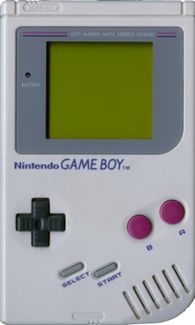
Il Game Boy (in giapponese: ゲームボーイ) è una consolle portatile di Nintendo progettata dal team interno R&D#1 capeggiato da Gunpei Yokoi. E' stato commercializzato in Giappone il 21 Aprile 1989, e negli Stati Uniti in Agosto. E' la prima consolle portatile di Nintendo, che già si era distinta negli anni '80 nella produzione dei giochi elettronici portatili Game & Watch.
Descrizione
Fornito di un processore Z80 della Sharp personalizzato per le esigenze di gioco, alimentato a batterie stilo, è dotato di un piccolo schermo LCD integrato capace di varie tonalità di grigio su fondo verde. Il quadro comandi consiste di una croce direzionale di colore nero posizionata sulla sinistra della consolle, di due pulsanti rossi sulla destra e dei tasti select e start in basso al centro. I giochi di tale consolle sono venduti su cartucce di dimensioni contenute, adatte ad un facile trasporto. Di questi, Tetris è stato il gioco che ha inizialmente spinto le vendite del portatile di Nintendo rendendolo popolare in tutto il mondo.
|
Specifiche Tecniche
CPU: Custom 8-bit Sharp Z80 a 4.194304 MHz (differente dallo standard Z80, e ha il suono integrato)
RAM: 8 kByte S-RAM interna
ROM: cartucce da 256 kbit, 512 kbit, 1 Mbit, 2 Mbit and 4 Mbit and 8 Mbit
Video RAM: 8 kByte interna
Suono: 4 canali stereo. L'unità ha un solo speaker, ma l'uscita audio per le cuffie è stereo
Display: LCD da 160 x 144 pixel
Schermo: 66 mm diagonale
Colore: 4 gradi di "grigio" (verde-nero)
Comunicazione: fino a 4 Game Boy collegabili via cavo
Batterie: 4 batterie tipo AA per circa 35 ore di gioco
pezzi venduti 120 milioni
Cartucce
Tipica cartuccia del Game BoyOgni gioco è scritto su ROM contenute in piccole scatole di plastica grigia chiamate cartucce, aventi su una fessura una porta hardware per la connessione con la consolle. Le cartucce del Game Boy misurano 5.8 cm per 6.5 cm. Se è presente una batteria tampone le partite possono essere salvate, così da essere riprese in un secondo tempo dopo lo spegnimento della consolle.
La cartuccia viene infilata dall'alto nell'apposito alloggio. Se viene estratta durante il gioco il Game Boy si blocca, il suono si ferma e l'immagine si corrompe. Questa procedura in alcuni casi può compromettere la cartuccia stessa e/o rovinare i salvataggi di gioco, e per questo la levetta di accensione del Game Boy è dotata di un blocco che non permette di sfilare la cartuccia quando l'unità è accesa.
Riedizioni successive
Nel corso degli anni l'originale Game Boy di colore grigio ha subito alcuni blandi ritocchi di vario genere, atti a mantenerlo competitivo nel suo segmento di mercato.
Game Boy Play It Loud! (1995) - speaker più potente, varie colorazioni della scocca
Game Boy Pocket (1996) - dimensioni ridotte, schermo più nitido, utilizza due batterie di tipo AAA (mini stilo)
Game Boy Light (1997, solo Giappone) - schermo retroilluminato, utilizza due batterie di tipo AA (stilo)

console a 8 bit, periodo storico fmetà anni novanta, per molti di questi sistemi è possibile scaricare (download rom) le rom o le iso*
* le rom possono essere scaricate da altri siti web o sfruttando le risorse della rete, chi scarica deve averne il diritto legale.
|
|
|||||
|
|
|||||
|
|
